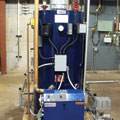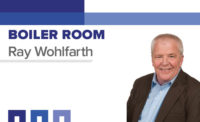A hybrid boiler system combines efficiency with longevity.

One of the choices to be made when tasked with a boiler replacement project is whether to use a condensing or standard efficiency boiler. Several considerations should go into that decision.
The first consideration is the type of mechanical system in the building. While condensing boilers are ideal for snow-melt, radiant floor-heating and water-source heat pump systems, there are some applications where a condensing boiler simply does not condense. It is like opening a pistachio nut and finding it empty. If the water temperature inside the boiler is greater than 140° F, a condensing boiler will not condense.
This benchmark temperature - 140° - separates the two boiler types. Standard efficiency boilers will condense when the water temperature is at or below 140°. Operation below 140° in a standard efficiency boiler will result in damage to the boiler flue and chimney. Condensing boilers will stop condensing when the water is above 140°. They actually lose efficiency the warmer the water is for the system.
On boiler brochures, right after the huge font proclaiming the efficiency of the uber-efficient boiler, is usually an asterisk. When you find the asterisk later in the brochure, the sentence following it typically will state that the boiler will reach those unbelievable efficiencies with 60° water. If you have a building filled with cast-iron radiators, 60° supply water will not raise the building temperature 1° on a 10° day.
In older applications, the original designer typically specified a system that would heat the building using 180° supply water at the design outside air temperature. At that supply temperature, the condensing boiler will not be condensing. It will be in the 84% to 88% efficiency range. This is slightly more than the mid-efficiency boiler range.
In Europe, where condensing boilers are more common, the designers oversize the heat emitters to allow lower water temperatures. Let us assume our existing heating system was designed using 180° water with fin-tube radiation. We now want to use 120° water to heat our building. To do so, we would have to have almost three times as much radiation as we originally had. We could have a wall filled with copper tubes and fins. In Europe, they are proud of their radiators and proudly display them. Over here, we hide them.
Another factor to consider is when the condensing boiler is used to heat either the domestic hot water or a swimming pool via a water-to-water heat exchanger. Commercial buildings require 140° water for the domestic water loop. If you require 140° water on the outlet of the heat exchanger, the water temperature has to be at least 10 to 20° higher in the boiler. That would make it 150°-160°. At that temperature, the condensing boiler is not condensing.
Estimated life
Condensing boilers are relatively new in our country and life expectancies are not well documented or published. According to the Chartered Institution of Building Service Engineers, the life expectancy is 15 years for a condensing boiler. According to UK Energy Saving, the estimate is a bit less at between 10 to 15 years. This is about half the life expectancy of a standard boiler. The project would have to generate huge savings to justify paying for two condensing-boiler replacement projects in the life of one standard boiler project.
Installation costs
When comparing a standard efficiency boiler with a condensing boiler, condensing boilers will typically cost 15% to 20% more than standard efficiency boilers.
The installation costs are usually higher for condensing boilers as well. They usually require a new flue to vent the products of combustion. In addition, the flues cannot be combined as they are pressurized and could spill flue gases into the idle boilers. In some instances, the flues have to be stainless steel.
The other consideration is sidewall-venting the new boilers. It is very difficult to meet the International Mechanical Code when venting several boilers through a wall where windows or air inlets are close.
Maintenance
Condensing boilers require more maintenance than standard boilers. The acidic conditions inside condensing boilers cause them to require cleaning much more often than standard boilers. This has to be factored into the life-cycle costing.
The cost of parts tends to be higher for condensing boilers than standard boilers as parts are proprietary and only available from the manufacturer.

Hybrid
What if you were able to have a heating system with the efficiency of a condensing boiler while having the longevity of a standard boiler system?
A hybrid system does exactly that; it combines a condensing boiler with a standard efficiency boiler. When the system water temperature is below 140°, the condensing boiler is the lead boiler and the standard one is the lag or backup boiler. When the water temperature is above 140°, the standard boiler is the lead boiler and the condensing boiler is the lag boiler.
There are several advantages to this, including lower fuel costs, reduced installation costs, reduced maintenance costs and longer life.
The first benefit when using condensing boilers in the proper application is that savings of 25% to 30% are common.
The second benefit is reduced installation costs. In a hybrid system, the new standard efficiency boiler should be able to reuse the existing stack or chimney. In addition, the standard boiler will probably not require combustion air vented from the outside as condensing boilers do.
Another benefit is maintenance will be less if half the heating plant is standard efficiency boilers, which have lower maintenance costs.
The last benefit is longer life. If the condensing boiler lasts 15 years as stated above and the standard boiler lasts 30 years, the condensing boiler’s life should be extended when using it as the lag boiler for almost half the winter.

